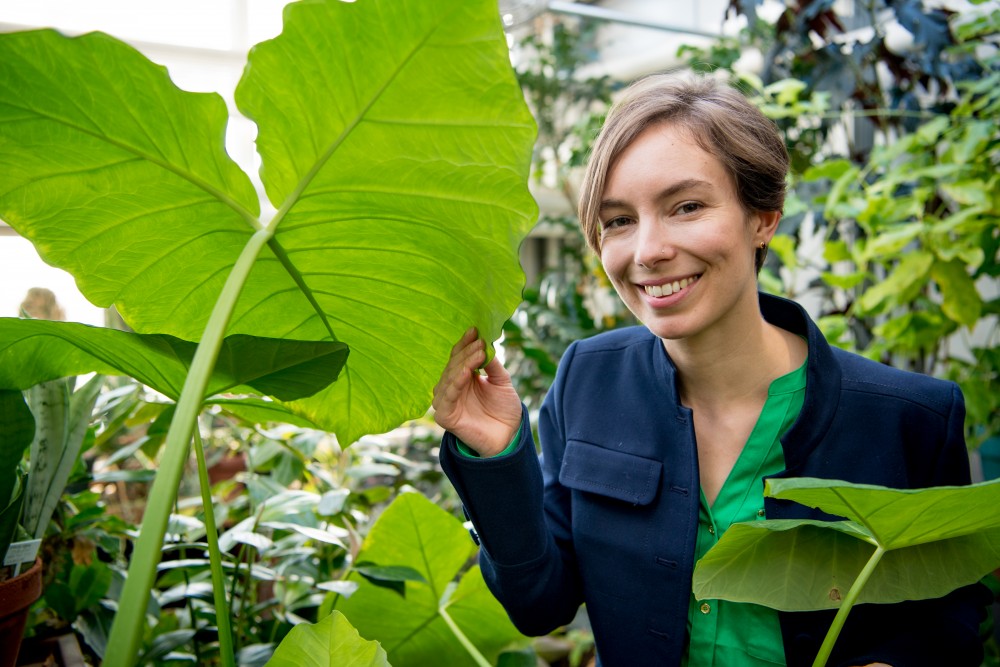She's climbed trees in tropical rainforests and studied photosynthesis of individual leaves. Now, she looks forward to studying forest canopies using measurements from a large helicopter drone.

Loren Albert, whose two-week field course in the Amazon inspired her to pursue her Ph.D. in plant ecophysiology and ecosystem science at the University of Arizona, is now, thanks to a BrownTogether Campaign gift from Corporation Fellow Peter Voss'68, P'98 and his wife Pamela, one of four Voss Postdoctoral Research Associates at the Institute at Brown for Environment and Society (IBES).
Here she talks about her pathway to postdoctoral work and the importance of her fellowship.
Describe how you came to be interested in Brown.
While working on my dissertation, I hired an arborist to help me scale tropical trees in the Amazon and measure photosynthesis. I was drawn to the idea that these forests are so important, and we still don't know enough about how they work to predict what they are going to do in the future. You can measure photosynthesis in individual leaves with instrumentation, but how do you get an estimate for a whole plant, let alone a whole forest? How do we scale up from these small estimates?
Brown Assistant Professor Jim Kellner came to speak at the University of Arizona when I was a graduate student, and later we talked about postdoctoral positions. He's been building the Brown Platform for Autonomous Remote Sensing with support from Brown and IBES; the platform is a constellation of sensors carried by a helicopter drone that we will use to study the structure and function of forests at totally new scales.
How have you enjoyed working with Asst. Professor Kellner?
Jim and I have complementary backgrounds and skill sets. I'm excited about this platform he's building and what we can do with it. The science is so limited in this area because it's technically challenging to study photosynthesis in forest canopies. Individual researchers and national space agencies see that the way to do this going forward is with remote sensing. With the Brown Platform for Autonomous Remote Sensing, we can manipulate aspects of data collection that research teams have not previously been able to control. This allows us to generate measurements at the right scale to obtain definitive answers. We'll have pixels that represent individual leaves instead of the kilometer (or larger) pixels produced by satellites.
Understanding the carbon cycle and understanding how long these forests can keep offsetting human-caused emissions is crucial. If...most countries are committed to keeping global temperatures from rising two degrees, we need to know how much forests are going to help us.
Loren Albert, Voss Postdoctoral Research Associate
Why is this work important?
Forests absorb about a quarter of the carbon dioxide that people emit. Understanding the carbon cycle and understanding how long these forests can keep offsetting human-caused emissions is crucial. If you think of the goals of the Paris Agreement, where most countries are committed to keeping global temperatures from rising two degrees, we need to know how much forests are going to help us. Part of the answer to that question lies in understanding how photosynthesis works.
Talk about the importance of your postdoctoral fellowship.
The postdoctoral fellowship is an opportunity to expand my skills in new directions before I dive headlong into a tenure-track academic position. Coming from plant biology, and with expertise at the leaf level, this position has allowed me to think about problems at different scales of investigation using new methods, including remote sensing.
It is also important to have research funds I can draw upon for professional development. I've presented at the Ecological Society of America meeting and attended a small meeting of a select group of researchers who are doing remote airborne sensing of photosynthesis. I'm also presenting my work as a Voss Postdoctoral Research Associate at the American Geophysical Union fall Meeting in New Orleans later in December. It's amazing to be a part of this small community of pioneering scientists.
I am grateful for this fellowship because it lets me embed myself deeper into the work. When you earn a doctorate, you're training to solve problems, and you want the opportunity to apply that training in the field. The Voss Fellowship is allowing me to do that and to build a network of colleagues that I will stay connected with throughout my career.
This story originally appeared at Brunonia. For more information, contact Kristin Dumont.